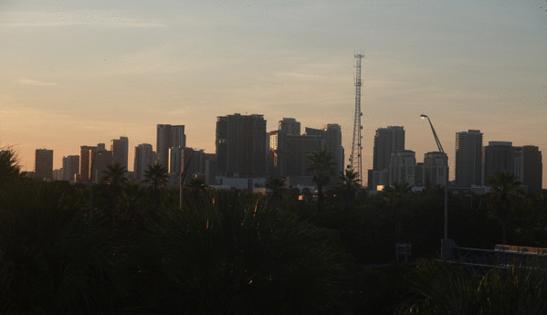Riding out a Category 5 hurricane in a high-rise: Should you stay or go?
Published in Weather News
FORT LAUDERDALE, Fla. — Can you ride out a Category 5 hurricane on the 50th floor? Would you want to?
You might not make it through the storm alive, experts say. Even if you do, your building won’t likely be the same when the storm is over. The South Florida Sun Sentinel spoke to five people in the know to find out how all those tall towers in Fort Lauderdale and throughout South Florida might fare in a Cat 5 — and whether people who live in a high-rise are better off heading out of town or staying put.
They all agree high-rise dwellers would be best off getting out of town. Here’s why.
Category 5 storms are the strongest, with sustained winds of at least 157 mph. They can bring deadly storm surge, heavy rainfall and devastating tornadoes. Knock down trees and power lines like twigs. And destroy even the most well-built buildings and bridges.
Hurricane season is approaching the peak period and runs through Nov. 30. Erin, the first hurricane of the season, intensified rapidly in just 24 hours from a Category 1 to a Category 5 as of Saturday morning. Forecasters expect Erin to steer clear of the U.S. mainland, but warned beachgoers there would be rip currents along the coastline early next week.
Only four Category 5 hurricanes have made landfall in the continental U.S. since 1900. Two hit Florida.
The Labor Day Hurricane hit the Florida Keys in 1935 with winds estimated at 185 mph. The storm killed more than 400 people and caused more than $100 million in damage, or $2.3 billion in today’s dollars.
Hurricane Andrew, another powerful Cat 5 storm with maximum winds of 175 mph, made landfall near Homestead on Aug. 24, 1992. Andrew left 65 people dead and caused $27 billion in damage, or $62 billion in today’s dollars. The widespread destruction triggered stricter building codes across the state.
The engineer
Anyone who rides out a Cat 5 storm in a high-rise should be prepared for an eyes-wide-open nightmare and an apocalyptic aftermath, warned Fred Bloetscher, a civil engineering professor at Florida Atlantic University in Boca Raton.
“You’re not going to have any water,” Bloetscher said. “The toilets are not going to flush. You won’t be able to take a shower. I drove through Homestead after Hurricane Andrew and there was no power line standing anywhere. So you probably won’t have power. That means you won’t have any AC. And if you lose power, you lose all your food in the fridge.”
Then there’s the wind factor.
High-rise buildings are built to withstand high winds, but the upper floors will likely get more wind and water damage.
100 Las Olas in downtown Fort Lauderdale is 499 feet high, the equivalent of 50 stories. But taller skyscrapers are on the way. One plan calls for a tower as tall as 55 stories and 609 feet, setting a new bar as the tallest building in town. Other developers are planning towers nearly as tall. Three would be 48 stories. Another two would be 47. Three would be 46.
The higher up you are in the tower, the stronger the winds will be, Bloetscher said.
“If you’re up 50 stories, you could have 200 mph winds coming at you,” he said. “I don’t know how well the glass will hold up. You’re going to feel the building move. It will vibrate. What if you lose your windows? Then the water’s all coming in. You’re just living in a situation that doesn’t get better any time quickly. Why would I want to stay?”
Newer towers built to hurricane code would be less vulnerable than older buildings, especially those that have not been maintained, Bloetscher said. But even new towers are not indestructible when it comes to a major hurricane.
If you were to ride out a Cat 5 storm in a high-rise, realize you might be stuck there for quite awhile if the ground floor and parking garage flood.
“It could be weeks, especially if you’re on the beach,” Bloetscher said. “You might survive the storm, but what are you going to do afterward?”
Maybe you get lucky and your condo doesn’t flood. But what if the one above you does?
“Keep in mind that concrete is not impervious,” Bloetscher said. “Water will go through the concrete and find its way to you. It’s like a roof leak. And now you’ll have mold, probably in your walls.”
If your neighbor fails to bring in the patio furniture or secure their windows, a couch or chair could be easily lifted by the winds.
“They could be picked up and moved,” Bloetscher said. “Now we have a flying couch. A flying chair. Could fall from above and break your window. Fifty stories up in a glass building on the coast. You could lose every window. If you lose one or two, you’ll lose a lot more because now you’ve got the wind in the building. That’s another reason I wouldn’t want to be there.”
The fire chief
If a Cat 5 is coming to town, Fort Lauderdale Fire Chief Stephen Gollan says he has no choice.
He’s staying put to oversee the city’s emergency response. But he plans to send his family far, far away, he said.
“I’m going to evacuate my family out of the area,” Gollan said. “South Florida hasn’t been tested with a Cat 5 storm since Hurricane Andrew. And the landscape of South Florida has significantly changed since then. There’s a lot of unknowns as to how that would play out. I don’t think people will realize what a Cat 5 is.”
There’s no reason to put yourself through a Cat 5 storm, Gollan said.
“People should leave for 48 hours and come back when it’s over,” he said. “There’s no reason to stay here. There’s going to be power outages and debris on the roadways. It’s way safer to leave the area and come back after it’s over.”
If you stay in your high-rise, expect to be on your own for up to seven days, Gollan said.
“We should be able to get resources in the area within a week as far as food and water,” he said. “But the normal comforts are not going to be available. A lot of the high-rises, the windows don’t even open. You’re on the 50th floor and there’s no elevators. No air conditioning. It creates challenges we’re not accustomed to on a daily basis. And potentially there could be delays in response time because of additional call volume and obstacles to get to you.”
If you’re planning to drive or fly out of town, don’t wait until the last minute, Gollan warned.
“That’s when the chaos settles in,” he said. “People need to plan for who they want to stay with, what city they want to head to. Waiting until days before the storm or when we’re in the cone, that’s too late.”
The FEMA expert
There’s a reason for a mandatory evacuation — to keep people alive, said Bill Brown, a former fire chief who is part of the Federal Emergency Management Agency’s Urban Search and Rescue support team.
Emergency management officials use the word “mandatory” to make sure people take it seriously, Brown said.
“The majority of people do take it seriously,” he said. “If you’re not going to listen to the authorities, make sure you have a Sharpie to write your name on your arm so they can identify you when they find you later.”
Even if you make it through the storm, it won’t be pretty on the other side.
“Once the storm passes, you would be without power,” he said. “You’d have limited water and food. The flooding could take out your emergency generators. There’s really no way to predict when the power would come back on. It could be several days or weeks. Keep in mind that hurricane season typically brings the hottest days of the year. Without AC, you could die from heat stroke. And emergency personnel can’t get to you till after the storm. They’re going to be so inundated with calls, they might not be able to get to you in time. It’s real simple: Leave.”
The developer
Developer Charlie Ladd still remembers how Hurricane Wilma, a Cat 2 storm, dramatically altered the local landscape.
Wilma came from the west, sweeping through Naples before hitting South Florida on Oct. 24, 2005, causing massive blackouts and leaving behind downed trees and mountains of debris.
“The power was out for a week,” Ladd said. “The roofs downtown used to have gravel on them. The gravel flew off and shattered windows on the School District headquarters.”
Imagine what a Cat 5 can do, Ladd said.
“The building codes changed in the early 1990s after Andrew,” Ladd said. “You don’t want to be in anything built before then. And if the buildings haven’t been maintained, then you have potential structural issues. Those are the biggies. And the power could be out for a week. That’s another reason why you leave.”
If a Cat 5 were on the way, Ladd said he plans to get out of town — and he doesn’t even live in a high-rise.
“I would never stick around, even if I lived in a small concrete hut,” Ladd said.
With the significant influx of new residents to South Florida, there’s a good chance a large portion of the populace has never experienced a hurricane, Ladd noted.
“We haven’t had a hurricane of any substance here for 20 years,” Ladd said. “So how many people who live here now have gone through one? And how many went through Andrew?”
The city commissioner
Fort Lauderdale Commissioner Steve Glassman knows you don’t mess around with a Cat 5.
As an elected official, he’s been through hurricane-preparedness training.
Glassman lives on the 10th floor of a 12-story condo. As president of his condo association for many years, he helped prepare the building’s annual hurricane plan. And there’s no way he’s sticking around with a Cat 5 on the way, he said.
“You should not be riding it out in a high-rise,” he said. “God forbid you have a heart attack, there’s no one coming to help you in a mandatory evacuation zone. You’ve got to go. You’re not going to have any power. It’s just foolish to stay.”
South Floridians really need to think about where they might ride out the storm before it’s on the way, Glassman said.
If a powerful hurricane is on the way, it’s important to keep track of where it might hit.
“You have to pay attention to the weather service and consider what the path is,” Glassman said. “Where you go depends on the path of the storm. They generally do come from the east but one year the storm came from the west. If you want to beat the traffic, the earlier the better. Get out of dodge.”
____________
©2025 South Florida Sun-Sentinel. Visit sun-sentinel.com. Distributed by Tribune Content Agency, LLC.







Comments